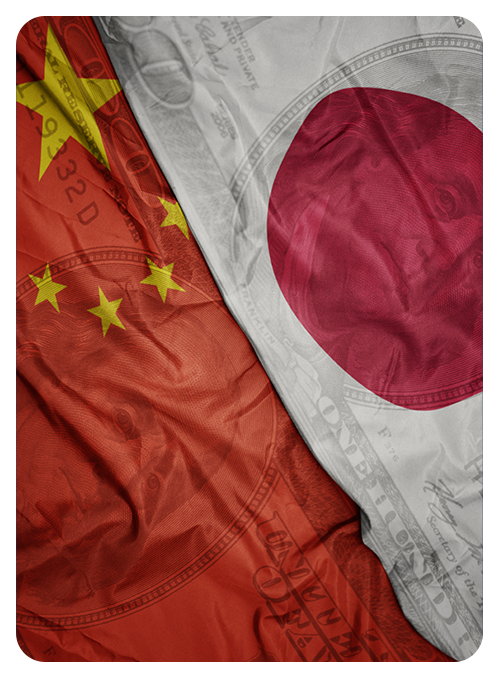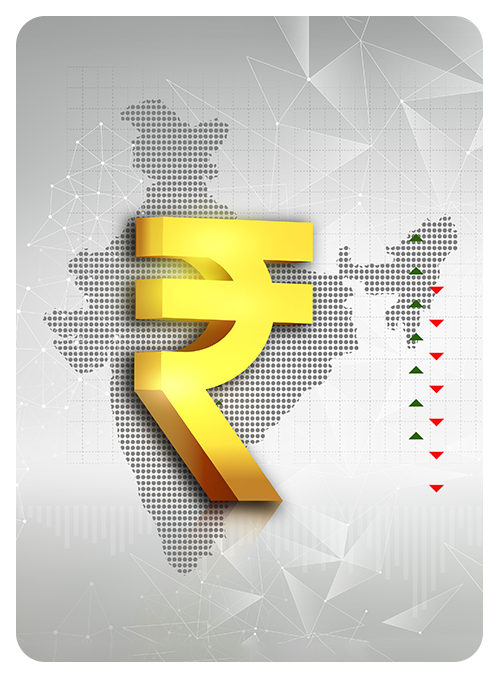Finsphere
From Recovery to Reversal:
Nifty Slips on Tariff Shock and Weak Earnings

Dear Clients and Stakeholders,
Indian equity markets, which had been on a recovery path following the sharp correction triggered by President Trump’s ‘Liberation Day’ tariff announcement, faced renewed pressure in July. Nifty declined -2.93% for the month, as stalled negotiations between India and the US culminated in the latter imposing 25% tariffs on Indian imports from 7th August, with additional 25% tariffs set to be effective from 27th August. Investor sentiment was further dented by underwhelming corporate earnings and cautious commentaries by management on medium term future outlook. Looking ahead, the evolving trade environment is expected to inject further volatility into markets in the weeks ahead.
Since Mr. Donald Trump assumed office, one of the first big moves under his administration was recalibration of trade relations with key partners by wielding tariff threats to hasten the negotiations. The tariffs and trade negotiations, which have dominated headlines since April reached a critical moment in July as most of its trading partners negotiated trade deals. Key trading partners such as EU, Japan and South Korea agreed to a 15% tariff on goods imported from the respective countries by US. While, countries that failed to reach a trade agreement with US were subject to stiff tariffs in the range of 10% to 50%. These include a 35% duty on many goods from Canada, 50% for Brazil, 25% base tariff and 25% additional tariff for India, 20% for Taiwan and 39% for Switzerland. Meanwhile, China, whose 90-day tariff truce has yielded little progress, is seeking an extension as negotiations drag on. With President Trump hinting at secondary sanctions on Russian oil importers, the global trade environment continues to be masked by uncertainty.
In US, investors rejoiced the passage of the much-awaited ‘Big Beautiful Bill’, macro print that suggested strength and the easing of tensions with key partners such as EU and Japan. US equity markets were buoyed as the S&P 500 gained 2.2% in July, the Nasdaq surged 3.7%, the broader Russell 2000 advanced 1.7% while DJIA ended nearly flat.
IMF in its World Economic Outlook for July 2025 revised global growth at 3% for 2025 and 3.1% in 2026. The upward revision reflects stronger-than-expected front-loading of trade ahead of tariff deadlines, lower-than-anticipated average US tariff rates, a weaker dollar, improved financial conditions, and fiscal easing in key economies.
United States
Growth Rebounds Even as Inflation and Labour Market Cool
The US economy bounced back strongly in Q2CY25, expanding at an annualized rate of 3%. The rebound was largely driven by a 30.3% plunge in imports, which had surged 37.9% in Q1 as businesses frontloaded purchases ahead of anticipated tariff hikes. Inflation showed renewed momentum. Headline CPI rose to 2.7% YoY in June — the highest since February — marking the second consecutive monthly acceleration. Core PCE, the Fed’s preferred metric, rose 0.3% MoM in June, the strongest monthly gain in four months. However, producer inflation was flat MoM in June, following a 0.3% rise in May, indicating some easing in pipeline price pressures.
Labor market data pointed to cooling momentum. The unemployment rate inched up to 4.2% in July — the highest since December 2022 — as the number of unemployed rose by 221,000 to 7.24 million. The labor force participation rate slipped to 62.2%, its lowest since November 2022, suggesting some weakening in labour engagement even as headline unemployment remains low.
The Federal Reserve held the policy rate steady at 4.25–4.50% for the fifth straight meeting in July, in line with market expectations. The Fed acknowledged signs of a moderation in economic activity in H1CY25 and retained its cautious stance amid persistent inflationary risks and elevated geopolitical uncertainty. While labor market conditions were still described as solid, concerns about slowing absorption remained.

Retail sales showed modest improvement in June, rebounding by 0.6% MoM following two consecutive months of decline. Industrial production rose 0.3% MoM in June while manufacturing output edged up 0.1%, indicating mild but broad-based recovery across categories. Housing data remained a mixed bag. Building permits rose marginally by 0.2% MoM in June, new home sales inched up 0.6%, existing home sales fell 2.7% MoM in June to 3.93 million units — the lowest since Sep’24 — amid persistent affordability pressures.
While the headline GDP recovery offers near-term relief, the underlying data point to fragility. Inflationary pressures remain sticky and with tariffs set to take effect; stickiness is expected to persist. Additionally, with labor market participation slipping and housing affordability under pressure, the trajectory of domestic demand and pricing trends would be key for future Fed rate adjustments.

Eurozone & UK
Tariff tensions push Central Banks to take Wait-and-Watch Stance
The Euro area economy grew 1.4% YoY in Q2CY25, marginally below the 1.5% print in Q1, as trade tensions and weak external demand weighed on momentum. The ECB now projects full-year growth at 0.9%, cautioning that 15% tariff on most EU exports to the US raised uncertainty over medium-term export competitiveness. Eurozone inflation ticked up to 2.0% YoY in June, meeting the ECB’s target and marking a reversal from May’s eight-month low. Meanwhile core inflation held steady at 2.3% — its lowest since Jan 2022. Against this backdrop, the ECB kept rates remained unchanged at 2%, pausing after eight cuts since June 2024 to assess the fallout from the US tariff regime and await clarity on future trade flows. Activity indicators painted a mixed picture. Industrial production rose 1.7% MoM in May, reversing April’s 2.2% contraction Retail sales rose 1.8% YoY in May, moderating from 2.7% in April but still exceeding market forecasts. Meanwhile, the trade surplus widened to EUR 16.2 billion in May, supported by a 0.9% rise in exports and a 0.6% decline in imports.
In the UK, inflation pressures remained firm. Headline CPI rose to 3.6% in June, its highest since Jan 2024, while core inflation also accelerated to 3.7% YoY. Labour markets showed further signs of weakness as unemployment rate rose to 4.7% in the three months to May — the highest since mid-2021.
On the activity front, retail sales rose 0.9% MoM in June, rebounding from a 2.8% decline in May. UK industrial production remained weak, falling 0.9% MoM in May — the first negative annual reading since January. Trade data provided modest relief. The UK trade deficit narrowed to GBP 5.7 billion in May as exports rose 1.2% MoM and imports edged up just 0.1%. Goods exports rose 2.2%, with shipments to the EU up 2.9% while non-EU exports grew 1.5% On the import side, total goods imports fell 0.2%.
Even as headline GDP growth and retail activity show resilience, both the Eurozone and the UK remain vulnerable to tariff-driven trade disruption and persistent inflation stickiness. Labour markets are softening, and monetary policy is now firmly in wait-and-watch mode. With key elements of the US-EU trade pact still unsettled, and business confidence fragile, the outlook remains highly sensitive to geopolitical and policy developments in the second half of the year.
Asia
Resilient Domestic Demand in Japan While China Rebounds on Stronger Industrial Output
Japan’s macro backdrop remained anchored by a cautious central bank and resilient domestic activity. The Bank of Japan left its benchmark short-term interest rate unchanged at 0.5% in July — the highest since 2008. Meanwhile, industrial production rebounded strongly in June with a 1.7% MoM rise while retail sales rose 2.0% YoY, marking the 39th straight month of gains. The Producer prices cooled to 2.9% YoY – the lowest since August 2024. Japan’s external balance improved with the current account surplus hitting 3.4 trillion yen in May, driven by a narrowing goods deficit and a services account swing into surplus. However, exports declined 0.5% YoY for a second consecutive month, highlighting lingering trade fragility despite import stabilization.
In China, Q2CY25 GDP expanded 5.2% YoY — a slight deceleration from prior quarters— underpinned by improved manufacturing output supported in part by Beijing’s policy measures amid a fragile trade truce. Retail sales slowed to 4.8% YoY, below expectations and well-off May’s holiday-driven spike while unemployment remained steady at 5.0%, the lowest since November 2024.

Industrial production growth accelerated to 6.8% YoY in June, supported by policy stimulus, while the trade surplus widened to USD 114.8 billion, the largest since January, as exports rose 5.8% and imports rebounded 1.1%. Consumer inflation edged into positive territory for the first time in four months (+0.1% YoY), while core inflation rose to a 14-month high of 0.7%. Still, producer price deflation deepened (-3.6% YoY), extending its streak to 33 months, underscoring subdued pricing power for producers.
With Japan treading carefully amid resilient domestic activity, China, though stabilizing, remains vulnerable to consumer softness and industrial overcapacity. As bilateral and US trade negotiations unfold, the trajectory of Asia’s largest economies will hinge increasingly on their ability to foster domestic resilience to avoid any adverse impacts from escalating global trade realignments.

India’s Economic Pulse:
Resilient Growth Amid Global Turbulence
India’s macro indicators in June–July offered a mixed yet steady picture. Disinflation deepened sharply, with CPI inflation easing to 2.1% — an over six-year low — driven by a sharp correction in food prices while WPI inflation turned negative at -0.13%, marking the first deflation print since October 2023. Further, RBI in its MPC meeting for August revised the inflation forecast to 3.1% from the earlier 3.7%. On the output side, India’s Industrial Production rose 1.5% YoY in June, improving from 1.2% but still undershooting expectations amid weak activity in mining and electricity. Infrastructure output also remained subdued at 1.7%, though steel and cement output saw traction due to export competitiveness. Labor market data was broadly steady — unemployment held at 5.6%, with rural improvements offsetting urban softness, while youth joblessness edged up to 15.3%.
Trade data signaled an improvement with India’s trade deficit narrowing to USD 18.8 billion in June from USD 21 billion a year ago, breaking a three-month widening streak. Imports declined 4% YoY, likely reflecting lower crude prices and softer commodity demand while Exports were broadly flat at USD 34.1 billion.
Forward indicators point to sustained underlying momentum. The Manufacturing PMI rose to 59.2 in July — the highest in over 17 years — on the back of accelerating domestic orders and strong output growth, although export order growth moderated. The Services PMI ticked up to 60.5, with foreign demand showing resilience. Policy support via RBI’s continued liquidity push to spur consumption could offset short-term external uncertainties. India’s macro positioning remains solid as domestic strength helps buffer global volatility.
Conclusion
As we navigate the second half of 2025, global macro conditions remain hostage to rapidly shifting trade dynamics. The US is navigating structural transitions driven by import tariffs and domestic tax reforms, while the Euro area continues to grapple with faltering growth. Japan and China, which are primarily export driven countries are facing turbulence amid constantly shifting global trade scenario. In contrast, India continues to stand out as a beacon of stability and growth, buoyed by favourable macroeconomic tailwinds — including a sharply moderating inflation trajectory, a smooth monsoon progression, and the onset of an interest rate downcycle.
At Chola Securities, we remain steadfast in our commitment to helping you navigate these complexities with clarity and foresight. As always, we aim to align your investments with evolving opportunities while ensuring resilience against emerging headwinds.
We sincerely thank you—our valued clients and investors—for your continued confidence and partnership. Together, we look forward to embracing the challenges and opportunities of the months ahead, ensuring sustained growth and success.
Warm Regards,
Mr. Senthilkumar Naidu
Chief Business Officer, CSec
